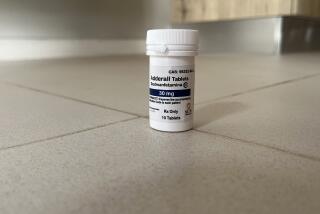Similar Names Confusing and Dangerous
- Share via
WASHINGTON — The patient needed an injection of Narcan but instead got the drug Norcuron and went into cardiac arrest.
More than 1,000 U.S. drugs have names that either look or sound so much alike that doctors, nurses and pharmacists can get them confused, dispensing the wrong one in errors that can injure or even kill patients.
Now a Chicago scientist has developed a computer program that may prevent some errors--by predicting which drugs will be most confusing so manufacturers can change the name or pharmacists can take extra care.
“If we can predict it, we should be able to prevent it,” said Bruce Lambert of the University of Illinois-Chicago, whose computer program is under trial use by the Food and Drug Administration.
An estimated 1.3 million Americans are injured each year from medication errors, such as administering the wrong dose or the wrong drug.
Nobody knows how many of those injuries are caused when health care workers mix up similarly named drugs, although studies suggest name confusion causes 25% to 30%, said Michael Cohen of the nonprofit Institute for Safe Medical Practices.
“There’s a finite number of letters of the alphabet and an awful lot of drugs out there,” said FDA pharmacist Ralph Lillie, who heads a new office that investigates medication errors, including those caused by confusing drug names.
Take Narcan, which treats morphine overdoses, and Norcuron, which can paralyze people’s breathing muscles. Four times this fall, Cohen’s institute recorded emergency rooms mixing up the two and then having to resuscitate some patients.
Pharmacists have accidentally given depressed patients the ulcer drug Prilosec instead of the antidepressant Prozac. And a man with an enlarged prostate took the osteoporosis drug Fosamax for three days before nurses noticed he should get the prostate drug Flomax.
When a drug name is similar, it’s easy to mistake a doctor’s scribble or blurry faxed prescription for the wrong drug. And a pharmacist operating in a noisy and hurried office can just forget and pick up the wrong bottle.
*
“The most effective way to deal with this issue is to cut it off at the pass--to get the right kinds of names out there in the first place,” Lillie stressed.
That’s where Lambert comes in. Using software that created computer spellcheck programs, he invented a program that pinpoints drug names likely to be confused. Consider nelfinavir and nevirapine, both AIDS drugs but with very different dosages and effects. They got a high confusion score because they both begin with “ne,” and the letters “f” and “v” sound alike.
Lambert tested how confusing 15 pharmacists actually found the drug names that the computer deemed very similar. The pharmacists read four drug names. Then they had to pick those drugs from another list that added four similarly named drugs.
They picked wrong up to 27% of the time, Lambert reported at this month’s American Assn. of Pharmaceutical Scientists meeting.
The FDA is using Lambert’s computer to help decide what brand names to let manufacturers use for new drugs. Lambert also is negotiating with the agency that sets a drug’s generic, or chemical, name.
But the bigger risk may come from older drugs that never got screened, Cohen said. Only rarely does the FDA ask a manufacturer to change a drug’s name after it hits the market.
Cohen, however, is lobbying Sanofi Inc. to actually stop making amrinone, which keeps getting mixed up with amiodorone. One drug slows heartbeat and the other strengthens it, so a mix-up can be deadly, said Cohen, who has persuaded some hospitals to stop buying amrinone.
A Sanofi spokesman wouldn’t say whether the firm was considering Cohen’s request, but did say it sells a better drug called milrinone that doctors could use instead.
But if manufacturers would screen their drugs’ names and change the confusing ones, “some patients’ lives and a lot of people’s troubles would be avoided,” said pharmacologist James O’Donnell of Chicago’s Rush Medical College.
More to Read
Sign up for Essential California
The most important California stories and recommendations in your inbox every morning.
You may occasionally receive promotional content from the Los Angeles Times.













